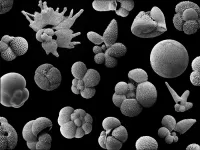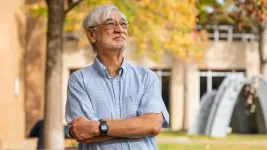Comparison of the “late catch-up” phenomenon between BuMA Supreme and XIENCE stents through serial optical coherence tomography at 1–2 month and 2 year follow-ups: A multicenter study
2024-04-23
(Press-News.org) https://www.scienceopen.com/hosted-document?doi=10.15212/CVIA.2024.0024
Announcing a new article publication for Cardiovascular Innovations and Applications journal. This study was aimed at comparing the “late catch-up” phenomenon between the BuMA Supreme bioresorbable polymer sirolimus-eluting stent and the XIENCE stent through serial optical coherence tomography (OCT) at within 2 months and 2 year follow-ups.
A total of 49 of 75 patients from the PIONEER-II study were enrolled in a 2 year OCT follow-up study; 44 patients with 50 lesions were included in the statistical analysis. The primary endpoints were neointimal thickness and late luminal loss (LLL) after stent implantation.
The stenosis diameter, and minimum in-stent or in-segment diameter, did not significantly differ between the BuMA Supreme and XIENCE arms at within 2 months and 2 year follow-ups. The strut neointimal coverage and thickness were greater in the BuMA group than the XIENCE group at the 1 and 2 month follow-ups (P = 0.044 and P = 0.010, respectively) but not at the 2 year OCT follow-up. Neither early luminal loss at the within 2 months follow-up (P = 0.849) nor LLL at the 2 year OCT follow-up (P = 0.613) showed differences between device arms. No significant differences in imaging and clinical endpoints were observed between device arms at follow-up.
The BuMA Supreme stent’s faster re-endothelization with no “late catch-up” phenomenon has potential advantages over the XIECE stent for patients with coronary artery disease and high bleeding risk because it decreases the duration of dual antiplatelet therapy.
CVIA is available on the ScienceOpen platform and at Cardiovascular Innovations and Applications. Submissions may be made using ScholarOne Manuscripts. There are no author submission or article processing fees. Cardiovascular Innovations and Applications is indexed in the SCOPUS, EMBASE, EBSCO, ESCI, OCLC, Primo Central (Ex Libris), Sherpa Romeo, NISC (National Information Services Corporation), DOAJ, Index Copernicus, Research4Life, CNKI Scholar (Chinese National Knowledge Infrastructure) and Ulrich’s web Databases.. Follow CVIA on Twitter @CVIA_Journal; or Facebook.
Qinhua Jin, Jianguo Cui and Changqian Wang et al. Comparison of the “Late Catch-Up” Phenomenon Between BuMA Supreme and XIENCE Stents Through Serial Optical Coherence Tomography at 1–2 Month and 2 Year Follow-Ups: A Multicenter Study. CVIA. 2024. Vol. 9(1). DOI: 10.15212/CVIA.2024.0024
END
ELSE PRESS RELEASES FROM THIS DATE:
2024-04-23
For hundreds of millions of years, the oceans have teemed with single-celled organisms called foraminifera, hard-shelled, microscopic creatures at the bottom of the food chain. The fossil record of these primordial specks offers clues into future changes in global biodiversity, related to our warming climate.
Using a high-resolution global dataset of planktonic foraminifera fossils that’s among the richest biological archives available to science, researchers have found that major environmental stress events leading to mass extinctions are reliably preceded by subtle changes in how a biological ...
2024-04-23
In a new study in Issues, Dominique J. Baker, an associate professor in the College of Education and Human Development and the Joseph R. Biden, Jr. School of Public Policy & Administration at the University of Delaware, explored the role of student loans on hopeful students striving for college degrees, particularly in STEM.
The cost of attending a public four-year college in the United States has more than doubled since the early 1990s, when inflation is factored in.
Undergraduate student loan debt has become unmanageable for a wide swath of borrowers ...
2024-04-23
As computer programming becomes an increasingly valued skill in the workforce, there is a greater need to understand how people learn to code most effectively.
Statistics show that up to 50% of students who enroll in introductory programming courses in the United States eventually drop out, suggesting a mismatch between how coding is learned and the way it’s taught. A new study from the University of Washington, published March 5 in Scientific Reports, examines that issue.
The researchers recorded electrophysiological brain responses of varyingly skilled programmers as they read ...
2024-04-23
Physicist Denis T. Keane is the 2024 recipient of the Gopal K. Shenoy Excellence in Beamline Science Award. He is a beamline scientist and director of the Dupont-Northwestern-Dow Collaborative Access Team (DND-CAT) at the U.S. Department of Energy’s (DOE) Advanced Photon Source (APS) at DOE’s Argonne National Laboratory. He is also a research professor in the Materials Science and Engineering Department at Northwestern University.
The annual award recognizes active beamline scientists at the APS, ...
2024-04-23
A small-scale surveillance system in Tanzania for reporting livestock abortions could help protect livelihoods and provide insights on potential livestock-to-human infections.
The research, published April 16 as a Reviewed Preprint in eLife, is described by editors as an important study with convincing findings of potential interest to the fields of veterinary medicine, public health and epidemiology.
Loss of livestock through abortion is a major concern for the worldwide livestock industry, resulting in significant ...
2024-04-23
Researchers have described the optimal timing for COVID-19 patients to take the antiviral, Paxlovid, to get the most benefit from the treatment, according to a study published April 16 in eLife.
The findings suggest that taking Paxlovid three to five days after COVID-19 symptoms emerge may maximise the drug’s ability to reduce viral loads, minimise viral spread and reduce viral rebound. They also indicate that broader use of Paxlovid during this window might be a powerful tool to help curb the spread of the SARS-CoV-2 ...
2024-04-23
INDIANAPOLIS—A new $4.8 million grant will support researchers from Indiana University School of Medicine and the Medical Research Council Laboratory of Molecular Biology to study how human neurodegenerative diseases are affected by the misfolding of the protein TDP-43. Misfolding occurs when a protein adopts a conformation which differs from the native one.
The researchers, funded by the National Institute of Neurological Disorders and Stroke, have developed an innovative approach to deciphering the role of TDP-43 misfolding in the pathology ...
2024-04-23
WASHINGTON, D.C. – The Department of Energy’s (DOE’s) Office of Science has selected 86 graduate students representing 31 states and Puerto Rico for the Office of Science Graduate Student Research (SCGSR) program’s 2023 Solicitation 2 cycle. Through world-class training and access to state-of-the-art facilities and resources at DOE national laboratories, SCGSR prepares graduate students to enter jobs of critical importance to the DOE mission and secures our national position at the forefront of discovery and innovation.
“The Graduate Student Research program is a unique opportunity ...
2024-04-23
Health-monitoring apps can help people manage chronic diseases or stay on track with fitness goals, using nothing more than a smartphone. However, these apps can be slow and energy-inefficient because the vast machine-learning models that power them must be shuttled between a smartphone and a central memory server.
Engineers often speed things up using hardware that reduces the need to move so much data back and forth. While these machine-learning accelerators can streamline computation, they are susceptible to attackers who can steal secret ...
2024-04-23
A rapidly spreading virus threatens the health of the cacao tree and the dried seeds from which chocolate is made, jeopardizing the global supply of the world’s most popular treat.
About 50% of the world’s chocolate originates from cacao trees in the West Africa countries of Ivory Coast and Ghana. The damaging virus is attacking cacao trees in Ghana, resulting in harvest losses of between 15 and 50%. Spread by small insects called mealybugs that eat the leaves, buds and flowers of trees, the cacao swollen shoot virus disease (CSSVD) is among the most damaging threats to the root ingredient of chocolate.
“This ...
LAST 30 PRESS RELEASES:
[Press-News.org] Comparison of the “late catch-up” phenomenon between BuMA Supreme and XIENCE stents through serial optical coherence tomography at 1–2 month and 2 year follow-ups: A multicenter study

